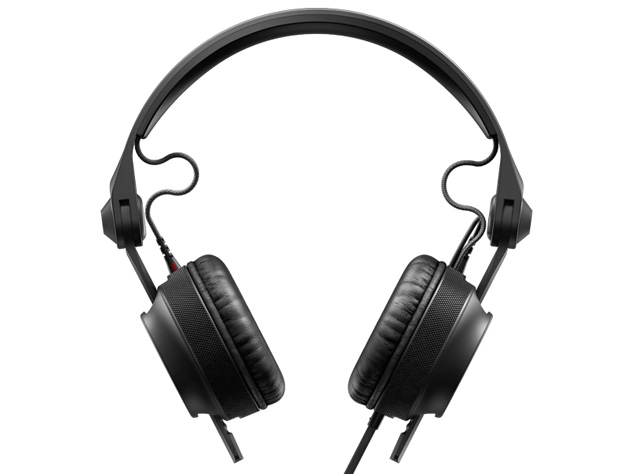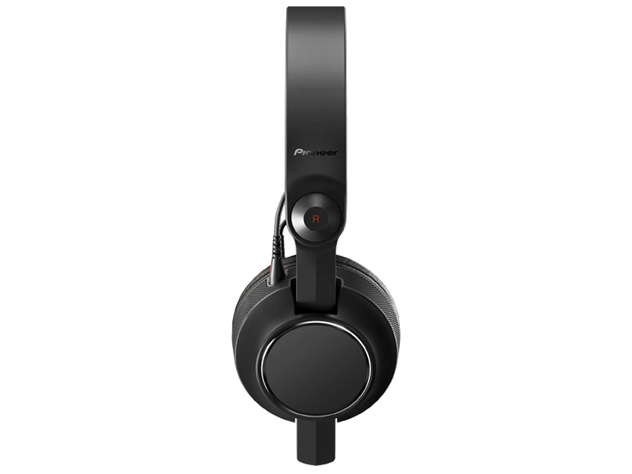- Pioneer DJ headphones boast a large professional fanbase, and the new HDJ-C70 model is conspicuous in that lineup. Where other designs have a showy appearance, these headphones are comparatively simple, in a uniform matte black shade and the brand logo inscribed minimally on the headband. With the compact rotatable housing, the cables passing through the upper headband and a slider design allowing for earpad adjustment, this model has much in common with the Sennheiser HD 25, known amongst DJs for their high-performance. If Pioneer's take on the headphone means a further refinement of what makes the HD 25 great, then this should be an exciting release.
Equipped internally with newly developed 40 mm aperture driver units using large-scale rare earth magnets, the HDJ-C70 offers a frequency range of 7 to 32,000 Hz. A copper cap has been attached to the ball piece of the units to reduce distortion. The output sound pressure level can reach 120 dB; when tested by raising the monitor levels on the mixer, the driver worked flawlessly, and the bass didn't distort until the levels bordered on maximum. The ear pads are a leather material and provide a great fit. The lateral pressure is relatively strong and provides an airtight sensation, though this seems to also be an effect of the sound-isolation chambers on the housing intended for reducing external noise. Additionally, the ear pads can be rotated by 90 degrees in either direction. This makes it possible to monitor with one ear while wearing the headphones over the head, as well as while the headphones are resting on the neck. The rubber grip featured externally on the housing provides further stability for monitoring when the headphones are placed around the neck. The monitors also have an anti-tangle cord. The headband, ear pads, housing and cords can all be interchanged.
 The power of the volume left the most significant impression from testing the HDJ-C70s, whether using records or when monitoring with digital DJ software such as Traktor—replacing the model with my usual DJ headphones, I noticed a remarkable difference in volume. The lack of distortion at high volumes was especially noteworthy, and it makes the headphones ideal for monitoring in the club environment. In terms of sound quality, at regular listening volumes there is something lacking in the high frequencies, but this is because the model has been tuned for DJing. The balance improves when the volume is increased, and it makes monitoring easier. The bass resolution was especially great at high volumes, and a clear feel of decay and attack can be attained when monitoring techno or house music. If the sonic strength of the Sennheiser HD 25 lies in the mid frequencies, then the HDJ-C70 adds a clearer bass to this sound.
The power of the volume left the most significant impression from testing the HDJ-C70s, whether using records or when monitoring with digital DJ software such as Traktor—replacing the model with my usual DJ headphones, I noticed a remarkable difference in volume. The lack of distortion at high volumes was especially noteworthy, and it makes the headphones ideal for monitoring in the club environment. In terms of sound quality, at regular listening volumes there is something lacking in the high frequencies, but this is because the model has been tuned for DJing. The balance improves when the volume is increased, and it makes monitoring easier. The bass resolution was especially great at high volumes, and a clear feel of decay and attack can be attained when monitoring techno or house music. If the sonic strength of the Sennheiser HD 25 lies in the mid frequencies, then the HDJ-C70 adds a clearer bass to this sound.
 Though the lateral pressure on the ears is strong, the headphones fit extremely well. I tested them at a live show recording, using them to monitor sound, but even when worn for several hours they weren't painful. Moreover, weighing 195 grams, they were so comfortable I could almost forget I was wearing them at all. The sound-insulating properties definitely make them ideal for DJing, but if the sound properties described earlier are understood, they should also be ideal for monitoring in a recording situation.
My tests left me with the sense that the HDJ-C70 could become a new standard model for DJ headphones. I have no doubt we will be seeing the model increasingly in the DJ booths of clubs. They're more affordably priced than the HD 25, and their sound quality is high in the context of a DJ headphone. For general listening, however, the resolution in the high frequencies was somewhat lacking, making them less than ideal for those purposes. So while they're not an almighty, perfect-for-every-application headphone, the HDJ-C70 has a lot of potential as a great new option for DJs.
Ratings:
Cost: 4.3
Versatility: 3.7
Sound: 3.6
Build: 4.5
Though the lateral pressure on the ears is strong, the headphones fit extremely well. I tested them at a live show recording, using them to monitor sound, but even when worn for several hours they weren't painful. Moreover, weighing 195 grams, they were so comfortable I could almost forget I was wearing them at all. The sound-insulating properties definitely make them ideal for DJing, but if the sound properties described earlier are understood, they should also be ideal for monitoring in a recording situation.
My tests left me with the sense that the HDJ-C70 could become a new standard model for DJ headphones. I have no doubt we will be seeing the model increasingly in the DJ booths of clubs. They're more affordably priced than the HD 25, and their sound quality is high in the context of a DJ headphone. For general listening, however, the resolution in the high frequencies was somewhat lacking, making them less than ideal for those purposes. So while they're not an almighty, perfect-for-every-application headphone, the HDJ-C70 has a lot of potential as a great new option for DJs.
Ratings:
Cost: 4.3
Versatility: 3.7
Sound: 3.6
Build: 4.5
 The power of the volume left the most significant impression from testing the HDJ-C70s, whether using records or when monitoring with digital DJ software such as Traktor—replacing the model with my usual DJ headphones, I noticed a remarkable difference in volume. The lack of distortion at high volumes was especially noteworthy, and it makes the headphones ideal for monitoring in the club environment. In terms of sound quality, at regular listening volumes there is something lacking in the high frequencies, but this is because the model has been tuned for DJing. The balance improves when the volume is increased, and it makes monitoring easier. The bass resolution was especially great at high volumes, and a clear feel of decay and attack can be attained when monitoring techno or house music. If the sonic strength of the Sennheiser HD 25 lies in the mid frequencies, then the HDJ-C70 adds a clearer bass to this sound.
The power of the volume left the most significant impression from testing the HDJ-C70s, whether using records or when monitoring with digital DJ software such as Traktor—replacing the model with my usual DJ headphones, I noticed a remarkable difference in volume. The lack of distortion at high volumes was especially noteworthy, and it makes the headphones ideal for monitoring in the club environment. In terms of sound quality, at regular listening volumes there is something lacking in the high frequencies, but this is because the model has been tuned for DJing. The balance improves when the volume is increased, and it makes monitoring easier. The bass resolution was especially great at high volumes, and a clear feel of decay and attack can be attained when monitoring techno or house music. If the sonic strength of the Sennheiser HD 25 lies in the mid frequencies, then the HDJ-C70 adds a clearer bass to this sound.
 Though the lateral pressure on the ears is strong, the headphones fit extremely well. I tested them at a live show recording, using them to monitor sound, but even when worn for several hours they weren't painful. Moreover, weighing 195 grams, they were so comfortable I could almost forget I was wearing them at all. The sound-insulating properties definitely make them ideal for DJing, but if the sound properties described earlier are understood, they should also be ideal for monitoring in a recording situation.
My tests left me with the sense that the HDJ-C70 could become a new standard model for DJ headphones. I have no doubt we will be seeing the model increasingly in the DJ booths of clubs. They're more affordably priced than the HD 25, and their sound quality is high in the context of a DJ headphone. For general listening, however, the resolution in the high frequencies was somewhat lacking, making them less than ideal for those purposes. So while they're not an almighty, perfect-for-every-application headphone, the HDJ-C70 has a lot of potential as a great new option for DJs.
Ratings:
Cost: 4.3
Versatility: 3.7
Sound: 3.6
Build: 4.5
Though the lateral pressure on the ears is strong, the headphones fit extremely well. I tested them at a live show recording, using them to monitor sound, but even when worn for several hours they weren't painful. Moreover, weighing 195 grams, they were so comfortable I could almost forget I was wearing them at all. The sound-insulating properties definitely make them ideal for DJing, but if the sound properties described earlier are understood, they should also be ideal for monitoring in a recording situation.
My tests left me with the sense that the HDJ-C70 could become a new standard model for DJ headphones. I have no doubt we will be seeing the model increasingly in the DJ booths of clubs. They're more affordably priced than the HD 25, and their sound quality is high in the context of a DJ headphone. For general listening, however, the resolution in the high frequencies was somewhat lacking, making them less than ideal for those purposes. So while they're not an almighty, perfect-for-every-application headphone, the HDJ-C70 has a lot of potential as a great new option for DJs.
Ratings:
Cost: 4.3
Versatility: 3.7
Sound: 3.6
Build: 4.5